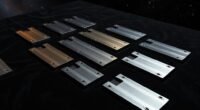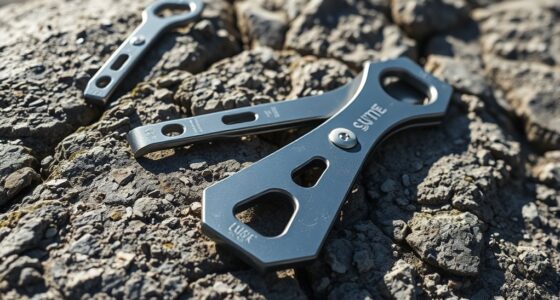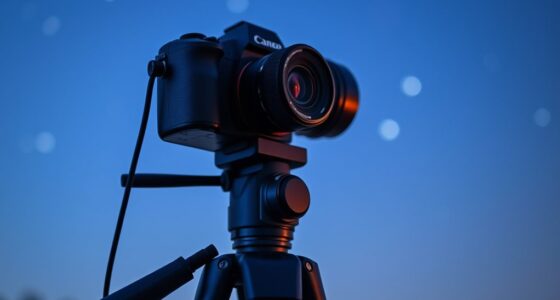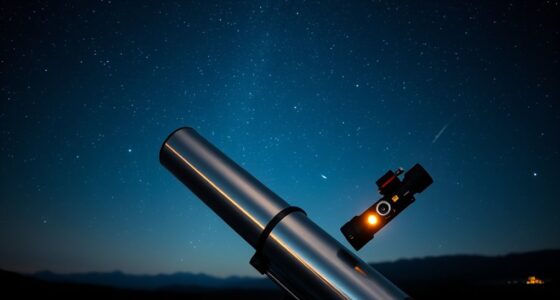To successfully guide long-exposure narrowband imaging, you need to guarantee your autoguider is well calibrated before starting. Regularly monitor your guiding graph for drift or oscillations and adjust parameters as needed. Use stable algorithms and avoid overcorrections that can cause oscillations. Environmental factors like temperature changes can affect guiding accuracy, so keep an eye on these and recalibrate if necessary. Staying proactive will help you achieve sharp, trail-free images over extended exposures—if you continue exploring, you’ll learn how to optimize every step for the best results.
Key Takeaways
- Regularly verify and recalibrate autoguider settings to maintain accuracy during extended narrowband exposures.
- Use stable guiding algorithms and fine-tune parameters to minimize drift and oscillations over long sessions.
- Monitor guiding performance with guiding graphs and adjust corrections proactively to prevent star trailing.
- Account for environmental factors like temperature changes and mount backlash that can affect guiding stability.
- Implement adaptive guiding strategies to compensate for gradual shifts, ensuring consistent image quality during long integrations.
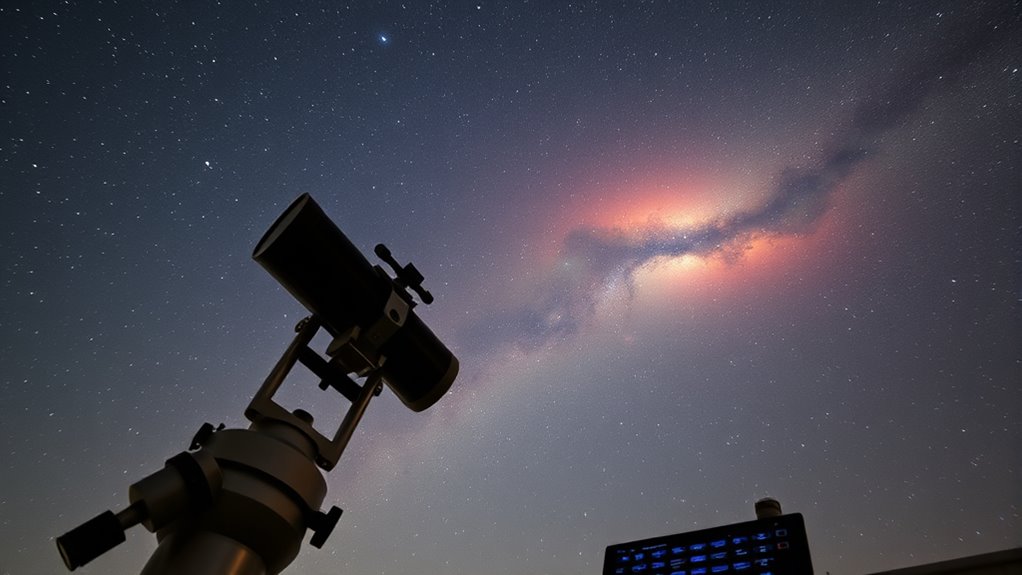
When capturing narrowband exposures, precise guiding is essential to guarantee sharp, detailed images of faint celestial objects. Since narrowband imaging involves long exposures, even minute tracking errors can cause star trails or image degradation, making accurate autoguider calibration imperative. Before starting your imaging session, spend time calibrating your autoguider carefully. Proper calibration ensures your guiding corrections are precise and consistent, which is critical when working with the extended exposure times required for narrowband. During calibration, you’ll need to select a suitable star and perform calibration movements in both axes, verifying that the guider’s response is accurate and symmetrical. This process helps your guiding system understand how to correct for drift effectively during your actual exposures. Additionally, understanding the importance of astrophotography techniques can help optimize your overall imaging setup for better results.
Guiding algorithms play an indispensable role in maintaining accurate tracking during long integrations. These algorithms analyze the position of the guide star and compute necessary corrections in real time. Different guiding algorithms, such as centroiding, pattern matching, or more advanced model-based approaches, offer varying levels of precision and responsiveness. For narrowband work, where exposure times can stretch into several minutes or more, choosing the right guiding algorithm can make a significant difference. A well-tuned algorithm minimizes guiding errors, helping you achieve pinpoint stars across the entire frame. You should also consider the software’s settings, adjusting parameters like correction aggressiveness, to optimize guiding stability without overcorrecting, which could introduce oscillations.
During your session, monitor guiding performance regularly. Check the guiding graph for signs of drift or oscillations, and adjust your guiding parameters if necessary. Keep in mind that environmental factors like temperature changes or mount backlash can affect guiding accuracy over long exposures. Using an autoguider with adaptive guiding algorithms that can compensate for such variables is beneficial. Additionally, periodically verify your autoguider calibration if conditions change or after a system reboot, ensuring your guiding remains accurate throughout the session.
Frequently Asked Questions
How Does Temperature Affect Guiding Accuracy During Long Exposures?
Temperature affects guiding accuracy during long exposures by causing thermal expansion in your mount and optical components, which can lead to misalignment. You need to regularly perform sensor calibration to account for these shifts, ensuring your guiding system remains precise. As temperatures fluctuate, these small changes can accumulate, so monitoring and adjusting for thermal effects helps maintain accurate tracking during extended, narrowband exposures.
What Are Common Signs of Guiding Errors in Narrowband Imaging?
Guiding errors in narrowband imaging are like a shaky lighthouse beam. You might notice elongated stars, streaks, or star trails indicating issues. Watch for inconsistent guiding corrections, which suggest miscalibration. Using proper polar alignment techniques helps minimize these errors. Regular autoguider calibration ensures your system tracks accurately. If you see star elongation or irregularities, it’s time to verify your calibration, polar alignment, and mount stability to keep your images sharp.
How Can I Troubleshoot Star Elongation During Extended Exposures?
To troubleshoot star elongation during extended exposures, start by checking your polar alignment; even slight misalignments cause elongation. Make sure guiding calibration is accurate, re-calibrating if necessary. Use guiding software to monitor real-time corrections and identify drift patterns. Adjust your mount’s polar scope or software alignment, and verify the guiding setup. Consistent calibration and precise polar alignment help minimize star elongation during long exposures.
What Equipment Upgrades Improve Long-Exposure Guiding Stability?
Imagine your telescope as a steady river, flowing smoothly without disturbances. Upgrading your autoguider improves its sensitivity and response time, helping you catch tiny deviations early. Strengthening mount rigidity reduces vibrations and flexing, ensuring your setup remains unwavering during long exposures. These enhancements work together to maintain precise guiding, so your images stay sharp and true, even during extended integrations, transforming your astrophotography into a seamless, stable experience.
How Do Atmospheric Conditions Influence Guiding Precision in Narrowband?
Atmospheric turbulence can cause rapid shifts in guide star position, reducing guiding precision, especially during narrowband imaging. If the guide star is faint, it becomes harder to track accurately, worsening your guiding stability. To improve, choose a brighter guide star when possible, and optimize your guiding settings to account for turbulence. Monitoring atmospheric conditions and adjusting your exposure times can help maintain better guiding accuracy during long narrowband integrations.
Conclusion
As you master guiding narrowband exposures, remember you’re the lighthouse guiding your telescope through the night’s silence. Each adjustment is a steady beam cutting through the darkness, revealing hidden wonders. Trust your skills as the beacon that keeps your images sharp and true, illuminating the universe’s secrets. With patience and precision, your long integrations become a voyage of discovery, where you’re the steady light leading your astrophotography journey toward breathtaking horizons.

